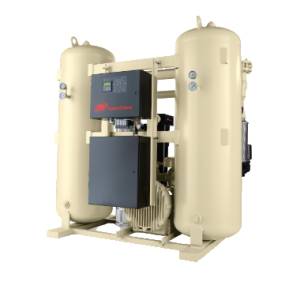Description
Desiccant Air Dryers: Superior Air Purity for Demanding Applications
Desiccant air dryers deliver the highest level of air purity, removing both liquid water and vaporized moisture to achieve extremely low dew points. Unlike refrigeration dryers, which are limited by ambient temperature, desiccant dryers provide consistent performance across a wide range of operating conditions, making them ideal for critical applications where even trace amounts of moisture can cause damage or inefficiency.
How They Work:
Desiccant air dryers utilize a desiccant material, typically silica gel or activated alumina, to adsorb (trap) moisture from compressed air. This process occurs in one or two towers, depending on the dryer's design. Air flows through the desiccant bed, leaving the moisture behind. Once the desiccant bed becomes saturated, it's regenerated by heating it with hot, dry air from a built-in heater. This process "desorbs" the trapped moisture, preparing the bed for another cycle of air drying.
Key Features and Benefits:
- Ultra-Low Dew Points: Achieve dew points significantly lower than those attainable with refrigeration dryers, typically reaching -40°F (-40°C) and even lower depending on the model. This ensures exceptionally dry air, protecting sensitive equipment and processes.
- Consistent Performance: Maintain consistent drying capacity regardless of ambient temperature or pressure fluctuations. This reliability is crucial in environments with varying conditions.
- Wide Range of Applications: Suitable for a broad spectrum of industries and applications, including:
- Instrumentation: Protecting sensitive analytical instruments and sensors from moisture damage.
- Manufacturing: Preventing corrosion, contamination, and malfunction in production processes.
- Pharmaceuticals: Ensuring the integrity of products and processes in sterile environments.
- Food and Beverage: Maintaining product quality and preventing spoilage.
- Textiles: Preventing moisture-related issues in textile manufacturing.
- Extended Equipment Lifespan: By removing moisture, desiccant dryers significantly extend the life of pneumatic equipment and prevent costly repairs due to corrosion and wear.
- Energy Efficiency: While requiring more initial energy input for regeneration, modern desiccant dryers are designed for optimal energy efficiency, minimizing operating costs over time.
- Types of Desiccant Dryers:
- Heatless (Heat-Regenerated): Utilizes a pressure swing to regenerate the desiccant, eliminating the need for a separate heater, leading to lower energy consumption. However, they typically achieve less extreme dew points than heat-regenerated dryers.
- Heat-Regenerated: Employs a heater to regenerate the desiccant, allowing for lower dew points and higher air flow rates. This method generally requires higher energy consumption.
Choosing the Right Desiccant Air Dryer:
Selecting the appropriate desiccant dryer depends on factors like:
- Required dew point: Determine the level of dryness needed for your specific application.
- Air flow rate: Match the dryer's capacity to your compressed air system's demand.
- Ambient conditions: Consider the temperature and pressure variations in your environment.
- Budget: Balance the initial investment with long-term operating costs.
Contact us today to discuss your specific needs and find the ideal desiccant air dryer for your application. We offer a range of models to suit diverse requirements and budgets. We can help you determine the best solution for maximizing efficiency and protecting your valuable equipment.
